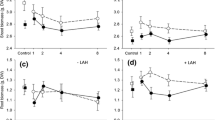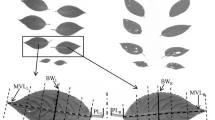Summary
Shoot development and damage by herbivores and pathogens to male, female and non-floral ramets of the dioecious, perennial herb Rubus chamaemorus were studied in the field during three consecutive years. Leaves on male ramets were usually consumed more by herbivores and attacked more by fungi than were leaves on female ramets. Male ramets unfolded their leaves later than did female ramets. In 1983, when the level of herbivory was comparatively high, ramets that were fully developed in early June were more damaged by herbivores than were ramets that unfolded their leaves later. Non-floral ramets usually showed intermediate levels of damage compared to male and female flowering ramets.
Defoliation caused a greater increase in ramet mortality among females than among males in a field experiment. It is suggested that the different reproductive roles of males and females differently constrain the evolution of defense against herbivores and pathogens in dioecious plants. This may result in intersexual differences both in palatability to herbivores and susceptibility to pathogens.
Similar content being viewed by others
References
Ågren J, Elmqvist T, Tunlid A (1986) Pollination by deceit, floral sex ratios and seed set in dioecious Rubus chamaemorus L. Oecologia (Berlin) 70:332–338
Agresti A (1984) Analysis of ordinal categorical data. Wiley, New York
Ahti T, Hämet-Ahti L, Jalas J (1968) Vegetation zones and their sections in northwestern Europe. Ann Bot Fennici 5:169–211
von Arx JA (1957) Mycosphaerella joerstadii auf Rubus chamaemorus. Acta Bot Neerl 6:337–340
Baker HG (1976) “Misstake” pollination as a reproductive system with special reference to the Caricaceae. In: J Burley, BT Styles (eds) Tropical trees: variation, breeding and conservation. Academic Press, London, pp 161–169
Barrett SCH, Helenurm K (1981) Floral sex ratios and life history in Aralia nudicaulis (Araliaceae). Evolution 35:752–762
Bawa KS (1980) Evolution of dioecy in flowering plants. Ann Rev Ecol Syst 11:15–39
Bawa KS, Opler PA (1978) Why are pistillate inflorescences of Simarouba glauca eaten less than staminate inflorescences? Evolution 32:673–676
Bullock SH (1984) Biomass and nutrient allocation in a neotropical dioecious palm. Oecologia (Berlin) 63:426–428
Chapin FS III, McKendrick JD, Johnson DA (1986) Seasonal changes in carbon fractions in Alaskan tundra plants of differing growth form: implications for herbivory. J Ecol 74:707–731
Chapin FS III, Shaver GR, Kedrowski RA (1986) Environmental controls over carbon, nitrogen and phosphorus fractions in Eriophorum vaginatum in Alaskan tussock tundra. J Ecol 74:167–195
Coley PD, Bryant JP, Chapin FS III (1985) Resource availability and plant antiherbivore defense. Science 230:895–899
Conn JS (1981) Phenological differentiation between the sexes of Rumex hastatulus: Niche partitioning or different optimal reproductive strategies? Bull Torrey Bot Club 108:374–378
Correns C (1928) Bestimmung, Vererbung und Verteilung des Geschlechtes bei den höheren Pflanzen. In: E Baur, M Hartmann (eds) Handbuch der Vererbungswissenschaft, Vol. 2. Borntraeger, Berlin, pp 1–128
Cox PA (1981) Niche partitioning between sexes of dioccious plants. Am Nat 117:295–307
Cox PA (1982) Vertebrate pollination and the maintenance of dioecism in Freycinetia. Am Nat 120:65–80
DanelL K, Elmqvist T, Ericson L, Salomonsson A (1985) Sexuality in willows and preference by bark-eating voles: defence or not? Oikos 44:82–90
Eurola S, Hicks S, Kaakinen E (1984) Key to Finnish mire types. In: PD Moore (ed) European mires. Academic Press London, pp 11–117
Gatin ŽI (1955) Biologičeskie osobennosti oblepichi i problema vvedenija ee v kul'turu dlja sadovodstva i lesnych polos. Problemy botaniki 2:339–374
Gikalov SJa (1935) Otnošenie konopli k boleznjam i vrediteljam. In: NN Griško (ed) Biologija konopli. Tr Vsesojuznogo naučno-issledovatel'skogo instituta konopli 8: 165–172
Gross KL, Soule JD (1981) Differences in biomass allocation to reproductive and vegetative structures of male and female plants of a dioecious, perennial herb, Silene alba (Miller) Krause. Am J Bot 68:801–807
Hancock JF, Bringhurst RS (1980) Sexual dimorphism in the strawberry Fragaria chiloensis. Evolution 34:762–768
Harper JL, White J (1974) The demography of plants. Ann Rev Ecol Syst 5:419–463
Heide F (1927) Observations on the pollination of some flowers in the Dutch East Indies. Dan Bot Ark 5:1–7
Herrera CM (1984) The annual cycle of Osyris quadripartita, a hemiparasitic dioecious shrub of Mediterranean scrublands. J Ecol 72:1065–1078
Hippa H, Koponen S (1975) On the damage caused by the species of Galerucella (Col., Chrysomelidae) on cloudberry (Rubus chamaemorus L.) in Finland and northern Norway. Rep Kevo Subarctic Res Stat 12:54–59
Hultén E (1971) The circumpolar plants. II. Sv Vetenskapsakad Handl Ser 4. 13:1 Almqvist & Wiksell, Stockholm
Kay QON, Lack AJ, Bamber FC, Davies CR (1984) Differences between sexes in floral morphology, nectar production and insect visits in a dioecious species, Silene dioica. New Phytol 98:515–529
Lloyd DG, Webb CJ (1977) Secondary sex characters in plants. Bot Rev 43:177–216
Loehwing WF (1933) Physico-chemical aspects of sex in plants. Proc Soc Exp Biol & Med 30:1215–1220
Lovett Doust J, Lovett Doust L (1985) Sex ratios, clonal growth and herbivory in Rumex acetosella. In: J White (ed) Studies on plant demography: a festschrift for John L. Harper. Academic Press, London, pp 327–341
Mantel N (1966) Evaluation of survival data and two new rank order statistics arising in its consideration. Cancer Chemother Rep 50:163–170
Neverova LA (1971) Sootnošenie raznopolych osobej i soderžanie v nich tanidov u nekotorych vidov ivy v okrestnostjach Ural'ska. Rast resursy 7:77–80
Onyekwelu SS, Harper JL (1979) Sex ratio and niche differentiation in spinach (Spinacia oleracea L.). Nature 282:609–611
Østgård O (1964) Molteundersøkelser i Nord-Norge. Investigations on Cloudberries (Rubus chamaemorus L.) in North-Norway. Forsk Fors Landbr 15:409–444
Putwain PD, Harper JL (1972) Studies in the dynamics of plant populations. V. Mechanisms governing the sex ratio in Rumex acetosa and R. acetosella. J Ecol 60:113–129
Redhead SA, Perrin PW (1972a) Asterobolus: a new parasitic hyphomycete with a novel dispersal mechanism. Can J Bot 50:409–412
Redhead SA, Perrin PW (1972b) Asterobolus: a synonym of Valdensia. Can J Bot 50:2083–2084
Resvoll TR (1929) Rubus chamaemorus L. A morphological-biological study. Nyt Mag Naturvid 67:55–129
Schladweiler P (1968) Feeding behavior of incubating ruffed grouse females. J Wildl Mgmt 32:426–428
Stanfield JF (1937) Certain physico-chemical aspects of sexual differentiation in Lychnis dioica. Am J Bot 24:710–719
Stephenson AG Bertin RI (1983) Male competition female choice, and sexual selection in plants. In: L Real (ed) Pollination biology. Academic Press, Orlando, Florida, pp 109–149
Taylor K (1971) Biological flora of the British Isles. Rubus chamaemorus L. J Ecol 59:293–306
Wallace CS, Rundel PW (1979) Sexual dimorphism and resource allocation in male and female shrubs of Simmondsia chinensis. Oecologia (Berlin) 44:34–39
Zimmerman JK, Lechowitz MJ (1982) Responses to moisture stress in male and female plants of Rumex acetosella L. (Polygonaceae). Oecologia (Berlin) 53:305–309
Author information
Authors and Affiliations
Rights and permissions
About this article
Cite this article
Ågren, J. Intersexual differences in phenology and damage by herbivores and pathogens in dioecious Rubus chamaemorus L.. Oecologia 72, 161–169 (1987). https://doi.org/10.1007/BF00379262
Received:
Issue Date:
DOI: https://doi.org/10.1007/BF00379262




